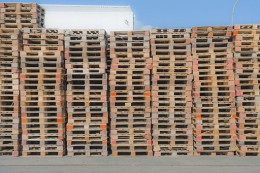More Than You Ever Wanted To Know About Shipping Pallets

This very long and informative article in Cabinet affirms my fascination with shipping pallets. Don’t think too much about pallets? That is fair. I didn’t either until I wanted to make a frame thing for our compost pile (frame made; pile long neglected). But now! Now I have ruined you, and you will see them EVERYWHERE, hanging out on street corners and in the corners of grocery stores, taking up space but still in the background somehow, all over the place. But just how all over the place are they? And where did they come from? Well, I’m glad you asked:
There are approximately two billion wooden shipping pallets in the United States. They are in the holds of tractor-trailers, transporting Honey Nut Cheerios and oysters and penicillin and just about any other product you can think of: sweaters, copper wire, lab mice, and so on. They are piled up behind supermarkets, out back, near the loading dock. They are at construction sites, on sidewalks, in the trash, in your neighbor’s basement. They are stacked in warehouses and coursing their way through the bowels of factories.
The magic of these pallets is the magic of abstraction. Take any object you like, pile it onto a pallet, and it becomes, simply, a “unit load” — standardized, cubical, and ideally suited to being scooped up by the tines of a forklift. This allows your Cheerios and your oysters to be whisked through the supply chain with great efficiency; the gains are so impressive, in fact, that many experts consider the pallet to be the most important materials-handling innovation of the twentieth century. Studies have estimated that pallets consume 12 to 15 percent of all lumber produced in the US, more than any other industry except home construction.
Also discussed: the history of shipping pallets, blue pallets vs ‘natural’ pallets (totally different species, apparently), major pallet lawsuits, unaccounted for pallets. Controversies abound!
The pallet industry boomed after the war, along with interstate highways, long-haul trucking, and the rise of a national consumer culture. The canneries of the Salinas Valley were early palletizers, followed by other grocery sectors, then the auto industry, then everything. In 1954, pallet manufacturers left the country’s wooden box association and founded their own trade group, the National Wooden Pallet and Container Association, or NWPCA. Its slogan: “Pallets move the world.” Sometime in the early 1970s, on a CBS news broadcast, John Kenneth Galbraith informed Dan Rather that pallets were the second-fastest-growing industry in America. “What are those?” Rather asked. Or so the legend goes.
Or so the legend goes.
Support The Billfold
The Billfold continues to exist thanks to support from our readers. Help us continue to do our work by making a monthly pledge on Patreon or a one-time-only contribution through PayPal.
Comments